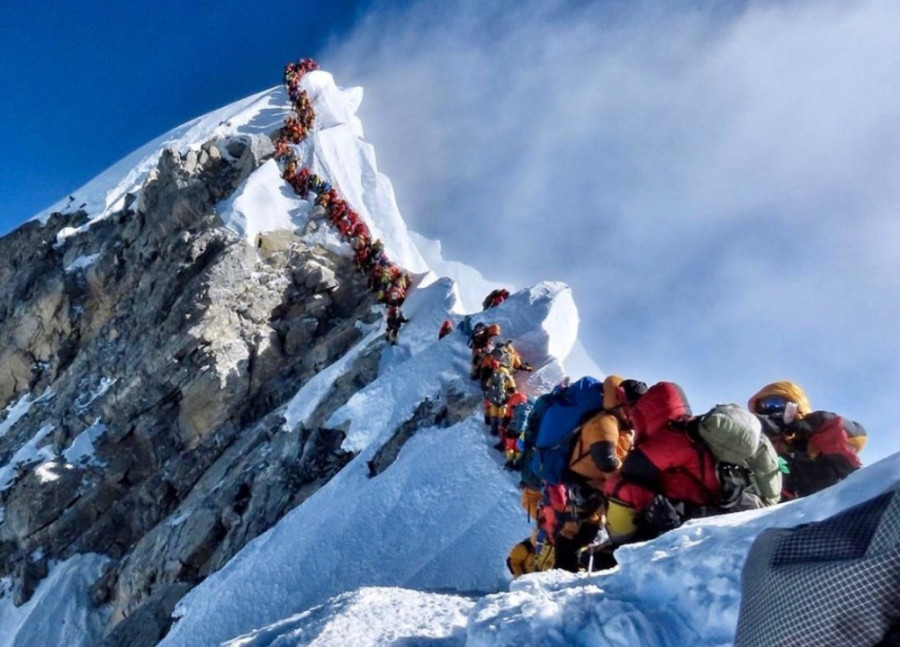National
Authorities consider barring weak climbers from Everest after a spate of deaths
Government may make it mandatory for climbers to take an advanced climbing course before joining an Everest expedition.
Sangam Prasain
The government is considering two options to limit the number of “weak climbers” attempting to scale Everest following the deaths of nine mountaineers in the rarefied slopes of the world's highest peak this climbing season that ended on Tuesday.
This is the highest death toll recorded on Everest in the last four years. Expedition organisers said two climbers died on May 23 due to loss of energy caused by a traffic jam.
Speaking at a press meet held on Thursday, to announce the first Asian Resilience Summit slated for Friday in Kathmandu, Tourism Secretary Mohan Krishna Sapkota said that the government was weighing two choices to ease traffic on the Everest following a wave of global criticism: conducting a medical checkup of the climbers at Everest base camp before allowing them to make the summit push, and making it mandatory for climbers to take an advanced climbing course before joining an Everest expedition.
It is a preliminary plan to make climbing safe, the secretary said.
Every year, the Himalayan Rescue Association deploys volunteer physicians to serve the medical needs of mountaineers and trekkers at Everest base camp.
“We can conduct medical checkups through the association’s doctors before letting climbers proceed to the mountain,” he told the Post.
Climbers currently need to provide a health certificate to obtain their climbing permit.
Meera Acharya, director of the Department of Tourism, said that many deaths on Everest were related to the climbers’ poor health condition. “They submit a medical certificate, and we don’t have any basis to stop them.”
The climbing season this year saw nearly 600 climbers reaching the hallowed peak.
The Department of Tourism issued a record 381 permits for Everest this spring climbing season.
On May 22, the longest single-day weather window lasting 24 hours experienced this decade led to 250 climbers making the push for the summit.
More than 200 mountaineers made it to the top. This record number of ascents claimed two climbers—Anjali Kulkarni, 54, from Mumbai and American Donald Lynn Cash, 55. Both of them died from exhaustion caused by the traffic jam, said their expedition organisers.
Kalpana Das, another Indian citizen who reached the summit on May 23, died while descending. Her expedition organiser said her death was not due to the traffic jam.
On December 28, 2017, the Cabinet’s Bill Committee had approved an amendment to the Mountaineering Expedition Regulation to bar double amputees and blind persons as proposed by the Department of Tourism, the agency responsible for issuing climbing permits.
The Supreme Court stayed the government’s ban on climbers with disabilities in March the same year.
An official of the department said that it was difficult to define 'weak climbers' and ask them not to climb.
A traffic jam can be especially dangerous above 8,000 metres, described as the Death Zone. Exhausted climbers are often forced to wait for several hours, awaiting their turn to ascend or descend on a single rope, increasing chances of exhaustion, frostbite or altitude sickness. Climbers could also run out of oxygen during the final phase of the descent.
Last year, the government had adopted a number of safety measures on Everest. One was a mandatory requirement for climbers to have at least five oxygen cylinders each. But Shanta Bir Lama, president of the Nepal Mountaineering Association, the apex mountaineering body, said that there are many climbers who don’t buy the required number of oxygen cylinders.
“The government should check ‘budget climbers’ who can’t afford to buy enough auxiliary oxygen,” he said, speaking at the 12th International Everest Day on Wednesday.




 14.72°C Kathmandu
14.72°C Kathmandu






%20(1).jpg&w=300&height=200)






